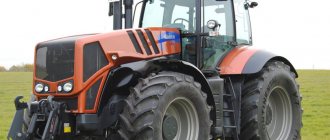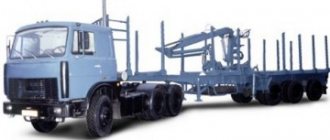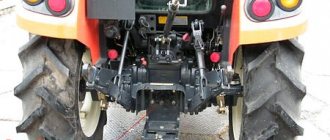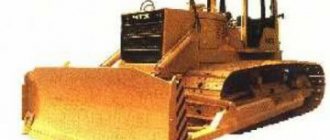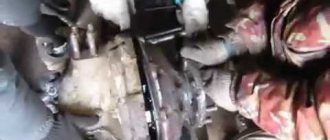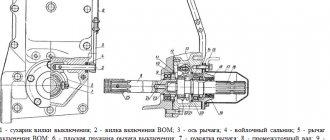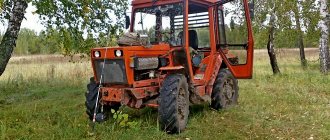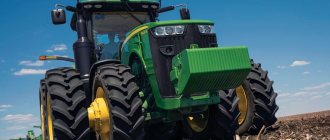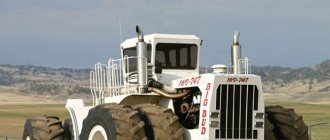Bulat 120
Bulat 120 is a budget model, but its functionality is pleasing. This mini-tractor is perfect for those who run a small farm, as well as for those who know a little about this type of equipment. You can install additional attachments on it.
One can note the single-cylinder R-192 engine, as well as a planetary gearbox. There is no differential lock and therefore 2-wheel drive can only be implemented when there is no additional load. It is for this reason that a mini-tractor can hardly be used as a double-furrow plow. The power is 11 hp, and the processing area is 0.5 hectares.
The country of origin is China, hence the inexpensive price. China makes good tractors. The low cost is due to a somewhat simplified design. In general, this is the right decision, because appearance is far from the most important thing in a mini-tractor. This model has average technical characteristics and a fairly low weight - 383 kg.
Scout T18 with soil cutter and canopy
Scout T18 is more functional and has a special canopy that protects the driver from bad weather and allows you to work in any conditions. In addition, the equipment is equipped with a soil cutter.
The mini-tractor is perfect for both small plots and real farms. Due to its increased productivity, the unit can process areas of up to 3 hectares.
Advantages of wheeled tractors.
A large wheeled tractor has a number of undeniable advantages; for its size it is not only powerful, but also quite maneuverable. It can be additionally equipped with attachments and trailers, which makes it versatile regardless of the time of year. The simple mechanical design and sufficient supply of spare parts make it easy to service this unit. It is economically profitable to buy a wheeled tractor of this brand; during operation, it is ready to replace several pieces of equipment. Due to its working resources, the K700, K701 tractor can increase the efficiency of agricultural work by 2-3 times.
Fighter T15
The Fighter T15 mini-tractor is quite small in size, but has many functions, as well as the ability to install attachments. Such devices can be all kinds of seeders, plows, lawn mowers and other auxiliary devices for cultivating the site. Power is 15 hp. and is quite suitable for working on areas up to 3 hectares.
A mini-tractor will do an excellent job with basic tasks, for example, dispersing various crops and harvesting them later. The only omission is the lack of a canopy. In this regard, the operation of the tractor is limited by weather conditions and the time of year in general.
The T15 fighter is compact and has dimensions of 220x115x140 cm. The weight of the equipment is 468 kg. The assembly and packaging will please you, since all the parts of this model are made of fairly high-quality materials. The gearbox has 4 speeds: 3 forward and 1 reverse. The price for a mini-tractor of this model is quite reasonable.
Modifications
There are three main types of this tractor. The T-150KS1 is equipped with a hydraulic attachment system, an independent power take-off shaft, a trailing shackle and a harness, a PZHB-300 preheater, a hydraulic hook, an evaporative air cooler and a breakaway coupling with hoses.
The T-150KS2 is equipped in the same way as the T-150KS1, but without the rear linkage, power cylinder with hoses, PTO, hydraulic hook and pre-heater.
T-150KSZ is a tractor with a hydraulic traction hook. It is equipped in the same way as the T-150KS1, but without a towing bracket and harness, PTO and pre-heater (a breakaway coupling with hoses is included with the tractor).
Numerous modifications were created on the basis of the T-150 family of tractors: the T-156 loader, the T-150D and T-150DK bulldozers, the T-155 military engineering tractor, the T-158 and T-157 industrial and forestry tractors, the ESVM-7 chemical treatment machine and etc.
Subscribe to our Telegram channel
Belarus MTZ 320.4 Lamborghini
This model can be classified as a mid-price mini-tractor. Outwardly, it looks like professional equipment, but has somewhat limited capabilities and reduced dimensions. The scope of use of such a mini-tractor is no longer limited to summer cottages or farms. It can be used in both construction and public utilities.
The main external difference between the Belarus MTZ 320.4 mini-tractor and the previous ones is the presence of a cabin with a roof, which can be removed if necessary. You can also note the internal heating system, air conditioning, and headlights.
The unit has a power of 36 hp, and the gearbox is equipped with 24 speed modes: 16 forward and 8 rear. This mini-tractor was produced in Belarus. The total area that it can cultivate reaches 20 hectares.
Externally, the mini-tractor looks quite large. With dimensions of 322x155x169 cm, it weighs 1720 kg. Maximum speed is 25 km/h.
Grasshopper GH 220
This mini-tractor also belongs to models in the middle price category, but its appearance is significantly different from the previous one. In this case, the mini-tractor has really small dimensions of 250x120x123.5 cm. The weight of the machine is 960 kg. The model does not have a full-fledged cabin and roof. Also, there is no canopy, so work on the tractor can only be done in favorable weather conditions. This is perhaps the only omission of the developers.
The Grasshopper GH 220 mini-tractor has a 4-cylinder engine and a special cooling system. Power is 22 hp, maximum speed is 28 km/h.
The equipment will cope perfectly with all the main tasks: uniform dispersion of crops, their collection, leveling of crushed stone or sand and much more. The rear-wheel drive modification allows you to install various auxiliary accessories on the device - a plow, a lawn mower, a rototiller. In general, such a mini-tractor is perfect not only for domestic purposes, but also for processing large areas.
Chery 404
Chery 404 belongs to the category of the most expensive mini-tractors. The appearance of the car is truly impressive. Dimensions 240x398x165 cm. Weight about 2000 kg.
The unit has a full-fledged cabin with a folding roof. In this regard, the mini-tractor can be used at any time of the year. The cabin of the mini-tractor is equipped quite comfortably; a comfortable seat allows the driver to work for a long time and not feel tired. The cabin is also equipped with a heating system and air conditioning.
The tractor wheel size is 8.3×20/12.4×28. This technique is quite suitable for use in the agricultural sector and for processing the most “difficult” areas. Among other things, special auxiliary devices can be attached to the mini-tractor. These can be lawn mowers, plows, and much more.
The power of the Chery 404 mini-tractor is 40 hp, but the processing area is limited to 10 hectares. The engine has a power of 29.4 kW and a traction force of 10.5 kN.
Branson 5220C
Branson 5220C can be classified as the most expensive. And this is quite understandable. The agricultural all-wheel drive motor allows you to cultivate large areas. The mini-tractor is suitable for use both on the farm and in larger-scale projects. The engine runs entirely on diesel fuel. The engine of the device has 4 cylinders and its power reaches 55 hp. It is thanks to it that the mini-tractor can accelerate to 23.8 km/h. The mini-tractor's gearbox has 24 speeds - 12 forward and 12 rear.
The appearance of the mini-tractor is also pleasantly surprising. It is somewhat similar to the Grasshopper GH 220 tractor, but differs in build quality. There is no doubt about the reliability of this unit. The dimensions are 331.6 × 132-182 × 236 cm. It is worth noting that the cabin here is completely closed, and its height can be changed at your discretion. That is, when ordering a mini-tractor, you must immediately indicate the desired height.
The cabin has a full heating system, as well as air conditioning. The seat is as comfortable as possible to reduce the load on the driver's back. Due to the fact that the cabin of the mini-tractor is completely sealed, you can work on it at any time of the year.
The weight is 2015 kg and the maximum load capacity is 1500 kg. Among other things, such a tractor can be equipped with various auxiliary devices such as a plow.
Other Features
The engine, together with the clutch and gearbox, is mounted on the tractor frame on four supports equipped with rubber-metal shock absorbers.
The T-150K has all driving wheels. The tractor is turned by the steering wheel using hydraulic cylinders acting on the articulated frame. Due to the “break” of the semi-frames in the horizontal plane, the tractor moves along a curved path.
The four-speed manual transmission, together with the clutch and engine, forms a common unit attached to the tractor frame on brackets and shock absorbers. The gearbox operates in several ranges (slow, working, transport and reverse), which are switched when the tractor stops. Gears are switched manually, without interrupting the power flow.
The T-150K has two brakes: central and wheel. The central handbrake is used for stopping in a parking lot. Wheeled is used to reduce the speed or completely stop a moving tractor.
KUBOTA B7100
This brand has mini-tractors in several series, represented by a large range of models. Only one series of KUBOTA mini-tractors is intended for farmsteads, while the rest are designed for work on larger areas.
Country of origin: Japan. It is the Japanese who try to make their devices as ergonomic and environmentally friendly as possible.
KUBOTA B7100 has a 16-25 hp diesel engine. It practically does not emit harmful gases into the atmosphere, and also works very quietly. The equipment is equipped with a powerful 3-cylinder engine. The gearbox is mechanical. The ground clearance of the entire line of this series is high and amounts to 240 mm. The track of the front and rear wheels is adjustable over a wide range. 9-speed transmission. It also features double locking. Maximum speed – 14 km/h. Not as large as previous models, but for basic tasks, namely municipal and agricultural work, it is quite suitable. Load capacity reaches 310 kg.
Main characteristics of the produced series:
- JX, JXT, QUANTUM C - compact low-power tractors equipped with: a gearbox with a number of automatic productivity control systems (AWM) and AFS precision agriculture (optimize all tractor parameters for specific types of work),
- PUMA, MAXXUM - multifunctional machines of medium power level: with the best in class, environmentally friendly turbocharged diesel, electronically controlled and with a large power reserve Cursor engine, Full Power Shift transmission, or continuously variable CVT, quick adjustment of the operation of attachments;
- Magnum, Steiger - the most powerful series of tractors for working in difficult conditions: with a supporting frame of the articulated Steiger Tractor design (reduce the turning radius), automatic transmission with electronic control, wide wheelbase, large load capacity of a three-point rear linkage, adjustable hydraulic system, compensating pressure and flow.
T 0.2 FROM ChTZ
This mini-tractor was manufactured in Russia at Chelyabinsk Tractor Plant-URALTRAK LLC. The plant produces equipment as an assistant in agriculture. The result exceeded all expectations. A mini-tractor can be useful in many branches of agriculture. It can also be used in the municipal and construction sectors. For farmers with small farms, this tractor can be useful for leveling sand, crushed stone, planting crops and their further collection.
The appearance of the T 0.2 mini-tractor is pleasantly surprising. The full cabin includes a cooling system. A comfortable seat allows the driver to work for a long time without putting stress on his back. The mini-tractor has a diesel engine, power – 12 hp. The package also includes hydraulic drive, 3-point hitch and much more. The main feature of this model is the transmission. Here it is six-speed: 5 forward gears and one reverse. Yes, it may sound funny compared to Japanese or Korean models, but for a Russian tractor model this is really a lot.
The T 0.2 mini-tractor has the ability to switch from a wheeled to a caterpillar drive.
Cabin of the T-150K tractor
The cabin of the T-150K tractor is a special pride of the designers! Never before has it been so comfortable and convenient. The tractor driver in it could feel like a real king.
The spacious (for two seats) all-metal sound- and dust-insulated sealed cabin is equipped with a ventilation and heating system, equipped with a sun visor, a first aid kit, rear-view mirrors and glass cleaners. There are even hooks for clothes and a thermos for drinking water! The driver's seat is sprung and adjustable depending on the weight and height of the driver.
Uralets-220
This mini-tractor model is a kind of upgrade of a new brand with the old “Uralets” filling. Uralets-220 originates in Chelyabinsk. Despite the fact that these tractors are produced in Russia, the assembly system is borrowed from China. This is due to the fact that the manufacturing company has been cooperating with a distributor of Chinese equipment for quite a long time. At first, tractors were made jointly, later Russia made its own line, which is now known throughout the world.
Speaking about the technical characteristics of this tractor, we should note its powerful diesel engine. It is equipped with 2 cylinders and 18 horsepower. Tractor weight 960 kg. The car does not have a full-fledged cabin. Therefore, it will not be possible to work during rain or snowfall. Roll bars are installed as additional options. This model also provides for the attachment of various hoes, seeders and other tools.
Price parameters of wheeled tractors.
The production of wheeled tractors for industrial and national sectors is a necessary matter. Despite its impressive size, one of the attractive qualities of the K700 models remains the possible options for equipping the unit and its cost. Having carried out a comparative analysis of machines with similar performance characteristics, we can safely say that the price for these wheeled tractors is quite optimal. Having assessed the operating efficiency of the mechanical equipment K700, K701, the degree of its depreciation and serviceability, the payback period for wheeled tractors of this brand creates an economically attractive option.
Let's sum it up
Choosing a mini-tractor is a rather labor-intensive and responsible task. The models presented above and their characteristics can be an excellent guide to the parameters that you should pay attention to when choosing and subsequently purchasing a tractor.
First of all, you should soberly assess the budget and purpose of the purchase. If these are small jobs in small areas, the Scout T18 would be an excellent solution. If you are planning larger-scale work, it is better to pay attention to the Branson 5220C. These models of mini-tractors combine all the optimal characteristics that should be present in this type of device; their price fully corresponds to the quality.
Review of popular tractor models
Despite the fact that new tractor models are constantly appearing on the market, the top sales are consistently occupied by proven models made according to Soviet models. Their advantages over more technologically advanced products include: reliability, unpretentiousness, maintainability, simplicity and low cost of maintenance. As a rule, the good old “Belarus” is chosen by rural residents who have extensive experience working with mechanisms and experience difficulties with the availability of professional service. Large businesses prefer products from world leaders - modern tractors made in Sweden or Japan are superior in terms of comfort and safety, and are also more economical in fuel consumption.
Russian
Among Russian models:
- Rostselmash 2375 is a heavy modern tractor equipped with an American Cummins engine with a power of 380 hp. With. and other technical innovations. When considering new generation tractors, Rostselmash products should be mentioned first. Meets in Rostov-on-Don. The company has almost a century-long history of successful production of agricultural machinery and replacement equipment.
- Agromash-180TK is a universal tractor from Cheboksary. Finnish SISU engine with 180 hp. With. makes the machine suitable for wide use both in fields and construction sites or city streets.
- Terrion ATM 7360 is a powerful, high-performance tractor with a 360 hp engine. s., the pride of the St. Petersburg company, which located its production facilities in Tambov. The company appeared on the market as a dealer of foreign equipment, and when it began its own developments, it attracted German partners. The products are distinguished by European quality, combined with Russian simplicity and affordability.
- K-744R is another powerful machine, developed and manufactured (formerly the Kronstadt Iron Foundry, founded in the century before last). Used with heavy wide-cut equipment.
- K-707T is a universal tractor of traction class 5, manufactured under the St. Petersburg brand “Baltiets”. The company also produces forestry, airfield, and municipal equipment of consistently high quality.
- KAMTZ TTX-215 is a universal tractor from the city of Naberezhnye Chelny. It is used in agriculture and municipal services, in the construction industry, etc. Production is carried out at the facilities of KamAZ.
- Alttrack T-501 is the brainchild of a manufacturer that has been specializing in equipment for logging and heavy engineering for many years. New crawler tractors, including the T-501, are widely used on swampy soils and deep snow.
Foreign
Among foreign models:
- The Fendt 900 Vario is a heavy German car with an economical 355 hp engine. With. The continuously variable transmission and the ability to reach speeds of up to 60 km/h make it an attractive option for large businesses.
- The Finnish-made Valtra N143V is designed for field work. Included in new tractors, equipped with a 150 hp engine. With. and powerful hydraulics. Stands out among its competitors for its superior traction force.
- Same Silver 95 is a product from an Italian manufacturer, suitable for any agricultural work. 95 l. pp., a comfortable cabin with air conditioning, and excellent maneuverability make the “Italian” a good solution for medium-sized businesses.
- Fend 200 Vairo is a compact and lightweight machine, effective when working indoors (warehouses, factories), historical areas (narrow streets, courtyards) or small fields of complex shape. Thanks to the variety of technical characteristics, Fend has become even more popular in the CIS region than other brands of German tractors, almost displacing the famous John Deere in the top sales and noticeably ahead of Deutz-Fahr.
Comparison of wheeled and tracked tractors
At the point of contact between the rubber and the soil, the power of the tractor engine is converted into useful traction force. In recent years, along with the working width of the units, the power of tractors has increased significantly. Today, a standard tractor is approaching the 400 hp mark. But the main thing is that it is almost impossible to transfer even more power to the ground with such a technical concept.
What does the tractor pull?
Will the traction force be transferred to the ground only using tracks in the future, or will the new wheeled concept allow for equally efficient power transfer? To answer this question, we conducted an experiment by creating the “Wheels or Tracks” team. The team carried out a practical comparison of different undercarriage concepts from Fendt and Challenger during heavy tillage and discussed various solutions with the engineers.
A tractor can convert only 25% of its diesel energy into actual tractive effort. Most of it is lost in the chassis due to rutting and slipping. Simply increasing engine power often does not directly increase tractive power, since the force must be transferred to the ground. Physics marks the boundary here! Many factors influence the behavior of the tractor during traction work, such as the weight (in particular ballast) of the chassis and the area of its support, slipping and traction with the soil.
Weight
For traction work, each tractor needs a certain weight. All the same - wheeled or tracked - it cannot pull more than its own weight. Standard tractors achieve towing figures ranging from 0.4 to 0.7 parts of their own weight. This is the tractive force coefficient. It depends on the chassis and soil conditions (asphalt or off-road dirt). A coefficient of 0.5 means that the tractor can convert exactly half of its own weight into traction force.
Traction force
If you sum up the driving forces of all axles and subtract the rolling resistance from them, you get the total traction force of the tractor. The graph shows the effect of the type of chassis on traction force.
Thus, a 10-ton tractor with a coefficient of 0.5 has a traction force of approximately 5,000 daN on the field. This corresponds to approximately 5 tons. If a tractor must pull more under the same soil conditions, then simply increasing engine power is not enough for this. Along with power, it must also increase its weight, which for standard tractors means a loss of payload. This is the distinctive feature of articulated and crawler tractors - they must, first of all, pull, and not pull. Therefore, already when leaving the factory they have a large dead weight in order to be able to transfer engine power of about 600 hp to the soil.
The 20 ton tare weight alone far exceeds the permissible gross weight of standard large class tractors. Fully loaded, they tipped the scales at 27 tons - that's twice the Fendt 936's own weight! We now recalculate with a minimum coefficient of traction force utilization of 0.5, which already leads to a value of more than 13 tons.
Ballasting
Ballasting has a significant impact on tractive effort. For example, when increasing the adhesion weight of a 10 t tractor with 2 t ballast, the calculated traction force increases by 1,000 daN (by 1 t). The same effect is achieved by tractors when working with mounted units, which additionally load the rear axle of the tractor. This weight distribution increases the traction properties of the tractor without additional costs.
This is how, for example, traction control works. If the tractor and plow are overloaded, for example when the plow hits a harder layer of soil, the system reacts so that the plow is automatically raised a few centimeters. The weight of the plow places additional stress on the rear axle and the traction force increases. Some manufacturers utilize this force shift using hydraulic upper arms, transferring gravity from the implement to the rear axle of the tractor.
For this reason, standard tractors are designed with a three-point connection. Ultimately, they must not only pull the units, but also carry them. In accordance with this, axles and tires are installed on the tractor: large ones at the rear, and smaller ones at the front. Accompanying effect: the tractor is very maneuverable.
The tractor has almost no ability to transport wide mounted implements. They are too heavy and need their own chassis. This ensures that there is no load on the rear axle other than the ground load. Therefore, another ballasting is needed here. Heavy loads in the front and rear, although they compensate for the missing gravity, must still be moved across the field.
For articulated tractors, integral tractors, as well as multi-axle tractors, the situation is different than for standard tractors: first of all, they must pull, and not transport. Therefore, they move on huge wheels of equal size, and their weight is evenly distributed on the axle. The weight distribution of articulated tractors is even more extreme. Here, even up to 60% of the weight “rests” on the front axle, which is why the front part of articulated tractors protrudes strongly in front of the axle. 20 tons of dead weight of such tractors can be turned into 27 tons with the help of additional ballasting and make the tractor a real giant.
During heavy pulling work, a standard tractor operates at the limit of its capabilities.
Good ballasting is also very important for a crawler tractor. Crawler tractors are significantly shorter than articulated tractors. Thanks to the colossal torque, which is transmitted through the rear drive gear, the tractor can “rear up”, thereby relieving the front part of the chassis. In this case, the chassis has almost no ability to transmit force. The caterpillar belt must be completely in contact with the ground - only then can the crawler tractor fully transfer traction force to the ground. Therefore, precisely at the points of support load, it is necessary to balance the required traction force of the unit using ballast in the front or chassis.
Support area
Wheeled tractors, with the same weight and the same slipping, convert their own weight into traction to a lesser extent.
The support area is the surface in contact with the soil. To really turn high power into decent traction effort, when doubling engine power and weight, the support area must quadruple. A simple way to increase traction on wheeled tractors is to lower the tire pressure, which increases the tire bearing area. Practical experiments have shown that a decrease in pressure leads to an even greater increase in tractive effort than additional ballasting. On the contrary, too high tire pressure causes deep ruts just like too much ballast. This increases rolling resistance and fuel consumption. When moving across the field, the tractor, due to its sinking into the soil, constantly overcomes the earthen wedges formed in front of the wheels. If, in extreme cases, rolling resistance equals tractive effort, then the tractor cannot move. Therefore, the traction force increases on soft soils not only due to an increase in the support area, but also due to the low value of rolling resistance. And, the softer the soil, the greater the effect of reducing the air pressure in the tires on increasing traction.
The use of wide-profile tires and dual wheels does not automatically increase traction. Compared to single wheels, double wheels at the same air pressure have only a 35% larger support area. Since the load on each of the double tires is less than that of a single tire, at the same pressure the support area does not double, as it seems at first. Therefore, it is also necessary to reduce the pressure on dual tires!
Articulated tractors with a double pack of tires of the same size (for example, 8x710/70 R42) have a much larger support area than standard tractors and almost the same as crawler tractors.
But, at the same time, the width of the tractor reaches 5 m, which does not allow it to move on roadways. The situation is different for tractors with three or more axles - a Fendt Trisix with six 800/60 R34 tires, for example, occupies an area of almost 3.5 m2 and is still within the three-meter “border”. This “legitimizes” its movement on European roads.
The caterpillar belt provides the largest support area to date, comparable to the area of a completely deflated and stretched tire. The large crawler tractor from Challenger occupies an area of 4.2 m2.
Additional support rollers located between the drive and guide wheels provide better support. True, the pressure under the tape is not distributed completely evenly, so the actual support area is approximately 30% less. Track tension is especially important. A poorly tensioned track looks like a wrinkled rug. Of course, because of this, traction force is also lost, since the tension on the drive and guide rollers creates additional resistance that the tractor must overcome.
Slippage and traction
During traction work, the tractor chassis must transmit force to the ground. The more intense the adhesion to the soil, the better. The natural limit of force transfer is reached when the ground begins to be cut away by the track and the existing friction between the chassis and the ground is no longer sufficient to transmit traction. In this case we are talking about track slipping.
Tires and soil change shape when they interact. As slippage increases, the soil is cut off.
Slipping reduces the amount of power expended per unit area, correspondingly increasing fuel consumption per hectare. This undesirable phenomenon is usually called “loss of power due to slipping.”
It can't be done without slipping at all. The wheels require slipping during heavy pulling work as they only have a few studs for traction. When slipping occurs at 10-15%, the tires and soil change shape, thereby improving traction. At this point, the tires have traction with their full area.
The lower the tire pressure, the more studs engage the ground. Thus, when doing traction work, it is better to lower the tire pressure. At the moment immediately before slipping, maximum force transfer to the ground occurs. If there is a lot of slipping (especially on wet soil), loss of power, compaction and damage to the soil occur.
Due to the large support area, the track drive has many more spikes for traction. In dry soil it achieves a slip of 2-5%, which is a significant advantage for traction work. The picture of the track drive looks worse in wet conditions. Due to the large area of the caterpillar, the spikes do not penetrate deeply into the soil, and the caterpillar slips.
These drive differences affect the productivity of tractors. Standard tractors have a slippage of 15% during traction work. For example, for 1,000 hours of arable work with constant slipping, there are 150 hours of losses. At this time, the tractor and driver “work” without cultivating a single meter of soil.
Of course, with a caterpillar drive there are also time losses, but with an average slip of 5%, the losses are 100 hours less than with a wheeled tractor.
Multi-axle tractor-tractors have a different concept: since all the wheels are the same and move one after another along the same track, losses in overcoming rolling resistance and soil compaction are reduced.
Hence the advantage - the lugs of the rear tires fit into the track already laid by the front wheels. Moving according to the “trail after trail” principle reduces the drag coefficient, i.e. slipping.
Who is the king of traction power?
When it comes to universal applications, standard tractors are the number one choice. They are maneuverable in the fields and quite fast in transport mode. But their traction properties have their limits. To transfer the engine power of 400 hp to the soil. Dual wheels and ballast are required. But this will not bring standard tractors closer to large tracked and articulated tractors. Even larger wheels and an even greater weight of the tractor are almost impossible with this technical solution. The engine power of articulated tractors reaches the power of crawler engines. Due to their simplicity of design and rigid chassis, they are more affordable.
The same size wheels and huge mass give them certain advantages, but in order to transmit traction force to the soil, they need double or even triple wheels. This makes them too wide for use on roads and highways, so they are mainly used in large fields in Eastern Europe and Russia.
As an alternative, three- or four-axle tractors with 6 or 8 identical wheels may be available in the future. Not much wider than standard tractors, but with almost double the footprint they can be driven on roads without special permission. At the same time, during traction work, due to the “track to track” movement of the wheels, they have less slipping.
The king of traction in dry conditions is, of course, the crawler tractor. With long tracks it has maximum support area and better contact with the soil. With significantly less slipping compared to a wheeled tractor, a crawler tractor pulls heavier working implements across the field.
